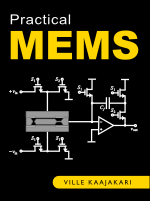Recommended MEMS books
If you are serious about learning MEMS and microsystems, I recommend the following MEMS books:
An Introduction to Microelectromechanical Systems Engineering
by N. Maluf 
Review:
Maluf gives a good introduction to MEMS manufacturing and applications. The book easy and inspiring to read. The level of treatment is almost non-technical: After reading this book, you will understand how MEMS devices work and how they are manufactured. However, this book is not in depth enough if you intend to design or fabricate microdevices. Recommended for new comers who want a gentle introduction and to (business) managers who need a crash course in MEMS jargon.
Microsystem Design
by S. Senturia 
Review: Microsystem Design is one of the first books to focus on design rather than manufacturing of MEMS. It contains a processing overview that is enough to understand how microdevices are made but is not extensive enough to be used as a guide for device fabrication.
The strength of the book is in mathematical modeling of microdevices. The treatment of lumped modeling, actuator dynamics, thermal actuation and beam modeling are excellent. The treatment of electronics is difficult to follow unless the reader is already familiar with amplifier circuits. The book contains several case studies that give a good overview of different microsystem aspects (design, manufacturing, and packaging). The case studies make an excellent job at highlighting some aspects of the device operation but are not sufficient to learn how to design the devices.
Micromachined Transducers Sourcebook
by G. Kovacs 
Review: Although this book is over 10 years old, it is still a solid introduction to the MEMS. Both fabrication and devices are covered. In comparison to the Madou's book, the Micromachined Transducers Sourcebook is less voluminous: it covers most important processing methods but more compactly. This brevity is compensated with an extensive list of reference.
The bulk of the book deals with transducers. As the name implies, the book catalogues a large number of different devices. Both conventional and MEMS sensors and actuators are illustrated. The strength of the book is the wide range of devices covered. Unfortunately, the analysis of the devices is rather superficial: After reading the book, you will be able to understand how the devices covered in the book work and how they are fabricated. But you will probably wonder if the devices presented are "good enough" for commercial applications.
All in all, the book is a great introduction to the field and a good source of ideas.
Fundamentals of Microfabrication
by M. Madou 
Review: Fundamentals of Microfabrication is the classic book on MEMS manufacturing. It is voluminous: This book serves both as a textbook and as a reference to manufacturing. The book covers both MEMS manufacturing and traditional processing methods. The tone is realistic: MEMS is not hyped as a solution to all problems.
Although the focus is on microfabrication, the processes in the book are illustrated with numerous device examples. The device analysis, however, is rather superficial and devices serve mostly as realistic application examples. If you are searching a design and analysis textbook, consider the Microsystem Design by S. Senturia or the Micro Electro Mechanical System Design by J. Allen.
Micro Electro Mechanical System Design
by J. Allen 
Review: This book has a good overview of MEMS with an overview of fabrication but is recommended here for its practical approach on device design. The book illustrates the practical design work with excellent illustrations on how the mask layout transfers to the actual device structure. The emphasis of the book is on surface micromachines.
Interestingly, the modeling of mechanical systems in the book is done using Lagrange's equations. While this is an elegant method, the approach can be a turn-off to non-physics students. On the other hand, the analysis of actuators, sensors, and electronics is clear and easy to follow.
The last chapter of the book on MEMS reliability is a gem.
Analysis and Design Principles of MEMS Devices
by Minhang Bao 
Review: This book focuses solely on mathematical modeling of micromechanical devices. By leaving out the fabrication details, the book is compact and to the point. Although only about 300 pages long, Bao's book is a good resource for analytical analysis. The strength of the book is in mechanical modeling of MEMS structures. Beams, diaphragms, and damping are covered.
Of actuation principles, only the electrostatic is covered. The choice is justified, as the electrostatic actuation is the most common actuation mechanism. The book covers the capacitive and piezoresistive sensing. The sensor transfer functions and electronics are investigated. Unfortunately, no quantitative comparison carried out and the reader will have to figure out the realitive merits for the sensors presented.
The book is heavy on equations and the author's native language is not English. This book is heavy reading and not recommended for novices. However, it is one of the better resources for a practicing MEMS designer.
Practical MEMS
by Ville Kaajakari 
Review: Just kidding - I am not going to review my own book. But as the name implies, the book focuses on practical MEMS device design and analysis. The book covers MEMS sensors (accelerometers, pressure sensors, gyroscopes), sensor electronics, actuators (capacitive, thermal, and piezoelectric), RF MEMS, optical MEMS, and microfluidic systems. In addition, the MEMS manufacturing economics is reviewed. Please visit the book's web-site for more information and sample chapters.
